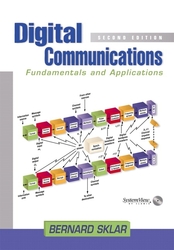Principles of Spread-Spectrum Communication Systems
暫譯: 擴頻通信系統原理
Don Torrieri
- 出版商: Demos Medical Publis
- 出版日期: 2004-11-09
- 售價: $1,580
- 貴賓價: 9.8 折 $1,548
- 語言: 英文
- 頁數: 455
- 裝訂: Hardcover
- ISBN: 0387227822
- ISBN-13: 9780387227825
-
相關分類:
Wireless-networks
下單後立即進貨 (約5~7天)
買這商品的人也買了...
-
 Visual C#.NET 程式設計經典
Visual C#.NET 程式設計經典$650$514 -
 重構─改善既有程式的設計
重構─改善既有程式的設計$720$569 -
 電腦網路 (Computer Networks, 4/e)
電腦網路 (Computer Networks, 4/e)$800$760 -
 Fedora Core 2 Linux 實務應用
Fedora Core 2 Linux 實務應用$650$553 -
 Head First Servlets & JSP:SCWCD 專業認證指南 (Head First Servlets & JSP)
Head First Servlets & JSP:SCWCD 專業認證指南 (Head First Servlets & JSP)$880$748 -
 Matlab 7 程式設計
Matlab 7 程式設計$680$578 -
 計算機組織與設計 (Computer Organization and Design: The Hardware/Software Interface, 3/e)
計算機組織與設計 (Computer Organization and Design: The Hardware/Software Interface, 3/e)$680$646 -
 深入淺出 Java 程式設計, 2/e (Head First Java, 2/e)
深入淺出 Java 程式設計, 2/e (Head First Java, 2/e)$880$695 -
 BIOS Inside:BIOS 研發技術剖析, 2/e
BIOS Inside:BIOS 研發技術剖析, 2/e$620$527 -
 Linux Kernel 完全剖析
Linux Kernel 完全剖析$750$585 -
 Java 認證 SCJP 5.0 猛虎出閘
Java 認證 SCJP 5.0 猛虎出閘$650$514 -
 SQL 語法範例辭典
SQL 語法範例辭典$550$468 -
 Linux 驅動程式, 3/e (Linux Device Drivers, 3/e)
Linux 驅動程式, 3/e (Linux Device Drivers, 3/e)$980$774 -
 精通 MFC 視窗程式設計─Visual Studio 2005 版
精通 MFC 視窗程式設計─Visual Studio 2005 版$750$593 -
 3D 電腦動畫及數位特效 (The Art of 3D Computer Animation and Effects, 3/e)
3D 電腦動畫及數位特效 (The Art of 3D Computer Animation and Effects, 3/e)$350$315 -
 Linux 作業系統之奧義
Linux 作業系統之奧義$480$379 -
 Head First 深入淺出 HTML、CSS 與 XHTML (Head First HTML with CSS & XHTML)
Head First 深入淺出 HTML、CSS 與 XHTML (Head First HTML with CSS & XHTML)$800$680 -
 精通 Shell Scripting (Classic Shell Scripting)
精通 Shell Scripting (Classic Shell Scripting)$620$490 -
 Visual C# 2005 程式設計經典
Visual C# 2005 程式設計經典$600$474 -
 鳥哥的 Linux 伺服器架設篇, 2/e & 鳥哥的 Linux 私房菜基礎學習篇, 2/e
鳥哥的 Linux 伺服器架設篇, 2/e & 鳥哥的 Linux 私房菜基礎學習篇, 2/e$1,560$1,326 -
 軟體測試實務講座─來自矽谷的技術經驗與心得分享
軟體測試實務講座─來自矽谷的技術經驗與心得分享$290$226 -
 現代嵌入式系統開發專案實務-菜鳥成長日誌與專案經理的私房菜
現代嵌入式系統開發專案實務-菜鳥成長日誌與專案經理的私房菜$600$480 -
 Embedded Linux 開發實務徹底研究 (Embedded Linux Primer: A Practical Real-World Approach)
Embedded Linux 開發實務徹底研究 (Embedded Linux Primer: A Practical Real-World Approach)$720$612 -
 軟體建構之道 (Code Complete, 2/e)
軟體建構之道 (Code Complete, 2/e)$1,200$1,020 -
 SQL Server 2005 資料庫實務應用
SQL Server 2005 資料庫實務應用$680$578
相關主題
商品描述
Description:
Originally adopted in military networks as a means of ensuring secure communication when confronted with the threats of jamming and interception, spread-spectrum systems are now the core of commercial applications such as mobile cellular and satellite communication.
This book provides a concise but lucid explanation and derivation of the fundamentals of spread-spectrum communication systems. The level of presentation is suitable for graduate students with a prior graduate-level course in digital communication and for practicing engineers with a solid background in the theory of digital communication. As the title indicates, the author focuses on principles rather than specific current or planned systems. Although the exposition emphasizes theoretical principles, the choice of specific topics is tempered by their practical significance and interest to both researchers and system designers. Throughout the book, learning is facilitated by many new or streamlined derivations of the classical theory. Problems at the end of each chapter are intended to assist readers in consolidating their knowledge and to provide practice in analytical techniques. Principles of Spread-Spectrum Communication Systems is largely self-contained mathematically because of the four appendices, which give detailed derivations of mathematical results used in the main text.
Table of Contents:
1 Channel Codes. 1.1 Block Codes Error probabilities for soft-decision decoding. 1.2 Convolutional Codes and Trellis Codes. 1.3 Interleaving. 1.4 Concatenated and Turbo Codes. 1.5 Problems. 1.6 References. 2 Direct-Sequence Systems. 2.1 Definitions and Concepts. 2.2 Spreading Sequences and Waveforms. 2.3 Systems with PSK modulation. 2.4 Quaternary Systems. 2.5 Pulsed Interference. 2.6 Despreading with Matched Filters. 2.7 Rejection of Narrowband Interference. 2.8 Problems. 2.9 References. 3 Frequency-Hopping Systems. 3.1 Concepts and Characteristics. 3.2 Modulations. 3.3 Codes for Partial-Band Interference. 3.4 Frequency Synthesizers. 3.5 Problems. 3.6 References. 4 Code Synchronization. 4.1 Acquisition of Spreading Sequences. 4.2 Serial-Search Acquisition. 4.3 Acquisition Correlator. 4.4 Code Tracking. 4.5 Frequency-Hopping Patterns. 4.6 Problems. 4.7 References. 5 Fading of Wireless Communications. 5.1 Path Loss, Shadowing, and Fading. 5.2 Time-Selective Fading. 5.3 Frequency-Selective Fading. 5.4 Diversity for Fading Channels. 5.5 Rake Receiver. 5.6 Error-Control Codes. 5.7 Problems. 5.8 References. 6 Code-Division Multiple Access. 6.1 Spreading Sequences for DS/CDMA. 6.2 Systems with Random Spreading Sequences. 6.3 Wideband Direct-Sequence Systems. 6.4 Cellular Networks and Power Control. 6.5 Multiuser Detectors. 6.6 Frequency-Hopping Multiple-Access Networks. 6.7 Problems. 6.8 References. 7 Detection of Spread Spectrum Signals. 7.1 Detection of Direct-Sequence Signals. 7.2 Detection of Frequency-Hopping Signals. 7.3 Problems. 7.4 References. A Inequalities. A.1 Jensen.s Inequality. A.2 Chebyshev.s Inequality. B Adaptive Filters. C Signal Representations. C.1 Bandpass Signals. C.2 Stationary Stochastic Processes. Power Spectral Densities of Communication Signals. C.3 Sampling Theorems. C.4 Direct-Conversion Receiver. D Probability Distributions.D.1 Chi-Square Distribution. D.2 Central Chi-Square Distribution. D.3 Rice Distribution. D.4 Rayleigh Distribution. D.5 Independent, Exponentially Distributed Random Variables
商品描述(中文翻譯)
描述:
最初在軍事網絡中採用,以確保在面對干擾和攔截威脅時的安全通信,擴頻系統現在已成為商業應用的核心,例如行動蜂窩和衛星通信。本書提供了擴頻通信系統基本原理的簡明而清晰的解釋和推導。這本書的內容適合具有數位通信研究生課程背景的研究生以及擁有堅實數位通信理論基礎的工程師。正如書名所示,作者專注於原則而非具體的當前或計劃系統。雖然本書的闡述強調理論原則,但具體主題的選擇受到其實際意義和對研究人員及系統設計師的興趣的影響。整本書通過許多新的或簡化的經典理論推導來促進學習。每章結尾的問題旨在幫助讀者鞏固知識並提供分析技術的練習。《擴頻通信系統原理》在數學上基本上是自足的,因為有四個附錄,詳細推導了主文本中使用的數學結果。
目錄:
1 通道編碼。1.1 區塊編碼 針對軟判決解碼的錯誤概率。1.2 卷積編碼和樹狀編碼。1.3 交錯。1.4 串接編碼和Turbo編碼。1.5 問題。1.6 參考文獻。2 直接序列系統。2.1 定義和概念。2.2 擴展序列和波形。2.3 具有PSK調變的系統。2.4 四元系統。2.5 脈衝干擾。2.6 使用匹配濾波器的去擴展。2.7 拒絕窄帶干擾。2.8 問題。2.9 參考文獻。3 頻率跳躍系統。3.1 概念和特徵。3.2 調變。3.3 針對部分帶干擾的編碼。3.4 頻率合成器。3.5 問題。3.6 參考文獻。4 編碼同步。4.1 擴展序列的獲取。4.2 串行搜索獲取。4.3 獲取相關器。4.4 編碼跟踪。4.5 頻率跳躍模式。4.6 問題。4.7 參考文獻。5 無線通信的衰落。5.1 路徑損失、陰影和衰落。5.2 時間選擇性衰落。5.3 頻率選擇性衰落。5.4 衰落通道的多樣性。5.5 Rake接收器。5.6 錯誤控制編碼。5.7 問題。5.8 參考文獻。6 代碼分割多重存取。6.1 DS/CDMA的擴展序列。6.2 具有隨機擴展序列的系統。6.3 寬帶直接序列系統。6.4 蜂窩網絡和功率控制。6.5 多用戶檢測器。6.6 頻率跳躍多重存取網絡。6.7 問題。6.8 參考文獻。7 擴頻信號的檢測。7.1 直接序列信號的檢測。7.2 頻率跳躍信號的檢測。7.3 問題。7.4 參考文獻。A 不等式。A.1 Jensen不等式。A.2 Chebyshev不等式。B 自適應濾波器。C 信號表示。C.1 帶通信號。C.2 平穩隨機過程。通信信號的功率譜密度。C.3 取樣定理。C.4 直接轉換接收器。D 機率分佈。D.1 卡方分佈。D.2 中心卡方分佈。D.3 Rice分佈。D.4 Rayleigh分佈。D.5 獨立的、指數分佈的隨機變數。












